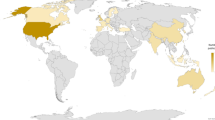Abstract
Big data mining and analysis based on computer technology provides a unique perspective for researching on enterprise’s brand crisis. All kinds of enterprise’s information are included in the visual field of observation through complete sample thought of the big data. Based on data processing and correlation analysis of information, we can find crisis information and predict the development trend of the crisis, so that the brand crisis can be suppressed and treated accordingly in the incubation period. Taking data analysis as the knowledge background, the paper researches the brand crisis factors and discusses the present appearance of brand crisis on the big data. Then constructs the brand crisis identify index system and identify model by cluster analysis and classification analysis and other methods and presents the results by clustering visualization, to provide intellectual support for the brand crisis management of the enterprise.















Similar content being viewed by others
References
Bell, W., Toffler, A.: The third wave. Soc. Forces 61(1), 298 (1982)
Cass, T.: A handler for big data. Science 282(5389), 636 (1998)
Manyika, J., Chui, M., Brown, B., et al.: Big data: the next frontier for innovation, competition, and productivity. Analytics 32(5), 121–123 (2011)
Zong-Ben, Xu, Zhi-Yan, Feng, Xun-Hua, Guo, Da-Jun, Zeng, Guo-Qing, Chen: Cutting-edge topic of the management and decision-making driven by big data. Manag. World 11, 158–161 (2014)
Dawar, N.: Product-harm crises and the signaling ability of brands. Int. Stud. Manag. Org. 28(3), 109–119 (1998)
Dawar, N., Pillutla, M.M.: Impact of product-harm crises on brand equity: the moderating role of consumer expectations. J. Mark. Res. 37(2), 215–226 (2000)
Dawar, N., Lei, J.: Brand crises: the roles of brand familiarity and crisis relevance in determining the impact on brand evaluations. J. Bus. Res. 62(4), 509–516 (2009)
Robrt Heath Crisis Management. Translated by Wang Cheng et al. CITIC Press, pp. 209–210 (2001)
Robrt, H, Crisis management. Translated by Wang Cheng et al. CITIC Press, pp. 218 (2001)
Gordon, B.M., Social cognition:understanding self and others, The Guilford press, pp. 112–113 (2005)
Li-Hong, Liu, Cai, Wang, Mo-Lei, Kang: Review of the theory of cognitive psychology classification. Psychol. Sci. 6, 540–543 (1998)
Xiao-Ling, Yan, Yi-Ping, Zhong: Heuristic strategy categorized in social cognition. Psychol. Sci. 2(3), 22–25 (2009)
Xue-Feng, Tang, et al.: Several mathematical theoretical models for the study of classification and reasoning. J Dev. Psychol. 3, 56–60 (2000)
Bruner, J.S.: On perceptual readiness. Psychol. Rev. 64, 123–152 (1957)
Erickson, M.A., Kruschke, J.K.: Rules and exemplars in category learning. J. Exp. Psychol. Gen. 127, 107–140 (1998)
Everitt, B.S., Dunn, G., et al.: Cluster analysis, pp. 115–136. Wiley, Hoboken (2011)
Author information
Authors and Affiliations
Corresponding author
Rights and permissions
About this article
Cite this article
Wenjun, X., Erna, Q. Research on brand crisis identify index model based on cluster analysis. Cluster Comput 22 (Suppl 2), 3495–3504 (2019). https://doi.org/10.1007/s10586-018-2197-9
Received:
Revised:
Accepted:
Published:
Issue Date:
DOI: https://doi.org/10.1007/s10586-018-2197-9




